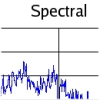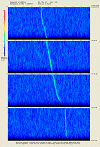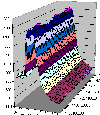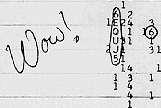|
Harry Kimball, N0TOU, recorded his first sun transit at Argus station EM29je on 20 June 2003, on a strip-chart recorder driven by a 3-meter dish, RAS cylindrical feedhorn with choke ring, RAS LNA, DEM downconverter, and Kenwood TS-700A ham transceiver. Harry writes: "The input to the chart recorder is connected across the S-meter on the Kenwood via a voltage divider (to get the ~200 mV max signal down within the 10mV range of the chart recorder; and I threw in a capacitor to give it about a 3 or 4 second time constant). I started it up in the morning before I went to work and found this peak when I got home. According to Starry Night software, the sun should have transited my location at about 1:22 PM CDT. In this recording it looks like I saw the sun go by at about 1:24, which would mean my dish azimuth is actually about 181.5 degrees rather than 180. I don't know how close my elevation setting is, but it looks like it can't be off too many degrees. I marked the chart levels corresponding to several S-meter readings on the picture. Assuming the 6 dB per S-unit rule of thumb, the peak is nearly 20 dB above the baseline. I don't know how accurate this is or what I should expect to see, but the signal to noise ratio makes me think that I'm off to a fairly good start."
|
| N0TOU image |
|

|
 SETI League Photo Gallery
SETI League Photo Gallery

































































